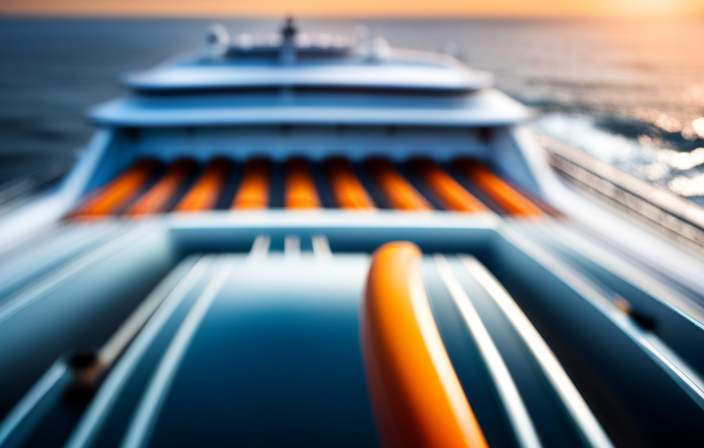Imagine driving down an expansive highway, gliding effortlessly as if you were navigating a ship as its captain. This is the allure of a car’s cruise control feature. It acts as an autopilot, maintaining a steady speed without the continuous need to press down on the accelerator.
In this article, I will delve into the benefits of using cruise control, how it works, different types of systems, common misconceptions, and provide tips for using it safely.
So, let’s set sail and explore the world of cruise control!
Key Takeaways
- Cruise control enhances comfort during long drives.
- Cruise control improves fuel efficiency.
- Cruise control reduces driver fatigue.
- Cruise control maintains a constant speed for optimal fuel consumption.
Benefits of Using Cruise Control
You’ll love the benefits of using cruise control on long drives.
Not only does it make your journey more comfortable, but it also offers significant advantages in terms of fuel efficiency and reduced driver fatigue.
When you engage cruise control, your car maintains a constant speed, optimizing fuel consumption.
By eliminating the need to constantly adjust your speed, cruise control ensures a smoother and more efficient drive.
Additionally, by relieving the driver of the task of maintaining a constant speed, it reduces the risk of fatigue.
This is especially beneficial on long trips, where driver fatigue can be a serious concern.
Now, let’s delve into how cruise control actually works and why it’s such a useful feature to have.
How Does Cruise Control Work?
It’s important to understand how cruise control functions in order to use it effectively. Here is a breakdown of how cruise control works:
-
Speed setting: Cruise control allows you to set a specific speed that you want your vehicle to maintain.
-
Throttle control: Once the speed is set, the cruise control system takes over the throttle control, adjusting it as necessary to maintain the desired speed.
-
Speed sensors: Cruise control uses speed sensors to constantly monitor the vehicle’s speed and make adjustments accordingly.
-
Disengagement: Cruise control can be disengaged by simply pressing the brake pedal or the cancel button.
Advantages of cruise control include reducing fatigue on long drives and improving fuel efficiency. However, there are also disadvantages, such as reduced control in certain driving conditions and the potential for distraction.
Now, let’s explore the different types of cruise control systems available.
Types of Cruise Control Systems
To understand the types of cruise control systems available, you can explore the different features and functionalities offered by each option. One popular type is adaptive cruise control (ACC). This system uses sensors to detect the speed and distance of vehicles ahead, automatically adjusting the car’s speed to maintain a safe following distance. ACC is particularly useful in heavy traffic or on long journeys where constant speed adjustments are required.
Another type is electronic cruise control (ECC), which allows drivers to set a desired speed that the vehicle will maintain. ECC is simpler in design and does not incorporate the advanced features of ACC. Both systems offer convenience and ease of use, making long drives more comfortable and efficient.
Now, let’s address some common misconceptions about cruise control.
Common Misconceptions About Cruise Control
One common misconception about cruise control is that it can automatically stop the vehicle in case of an emergency. However, this is not true. Cruise control is designed to maintain a set speed, but it does not have the ability to detect or respond to sudden changes in traffic or road conditions.
Relying solely on cruise control can be dangerous, as it may prevent drivers from quickly reacting to unexpected situations. It is important to remember that cruise control is a tool to assist with maintaining a steady speed on open highways, but it does not replace the need for attentive driving.
Being aware of the limitations of cruise control and understanding the potential dangers of relying on it is crucial for safe driving.
Now, let’s discuss some tips for using cruise control safely.
Tips for Using Cruise Control Safely
Make sure you’re aware of the speed limit and adjust your cruise control accordingly. Using cruise control can be a convenient and efficient way to maintain a steady speed while driving. However, it’s important to remember that cruise control is not suitable for all situations.
Here are some tips to use cruise control safely:
-
Keep an eye on the road: Don’t rely solely on cruise control, always be attentive and ready to react to any unexpected situations.
-
Maintain a safe following distance: Cruise control should not be used in heavy traffic or adverse weather conditions.
-
Avoid hilly terrain: Cruise control may cause your vehicle to accelerate or decelerate unexpectedly on steep inclines or declines.
-
Regular maintenance: Ensure that your cruise control system is functioning properly by scheduling regular maintenance checks.
Frequently Asked Questions
Can Cruise Control Be Used in All Types of Vehicles?
Yes, cruise control can be used in some motorcycles, but not all. However, it has limitations for heavy duty trucks due to their size and weight. It’s important to understand the specific compatibility and limitations for each type of vehicle.
Is It Safe to Use Cruise Control in Bad Weather Conditions?
Using cruise control in bad weather conditions can be dangerous due to reduced traction and visibility. It’s important to maintain control of the vehicle and adjust speed manually.
Can Cruise Control Save Fuel?
Yes, cruise control can save fuel by maintaining a consistent speed, which can help optimize fuel efficiency. However, it’s important to note that using cruise control may have potential drawbacks and can impact driver attentiveness and reaction time.
Does Cruise Control Work on Hilly Terrains?
Yes, cruise control does work on hilly terrains. Some cars even have a feature called hill descent control, which automatically adjusts the speed when going downhill. Adaptive cruise control can also adapt to changes in speed and maintain a safe distance from the car ahead.
Can Cruise Control Be Used in City Driving?
Using cruise control in city driving has its advantages, such as maintaining a constant speed and reducing fatigue. However, it also has its disadvantages, like reduced responsiveness and the potential for accidents in stop-and-go traffic.
Conclusion
In conclusion, cruise control is a remarkable feature that adds convenience and safety to our driving experience. It allows us to maintain a steady speed without constantly adjusting the throttle, reducing fatigue and improving fuel efficiency.
Understanding how it works and the different types available can help us make the most out of this technology.
Remember, ‘Smooth sailing with cruise control, brings comfort and control.’ So, next time you hit the road, don’t forget to engage cruise control for a smoother and more enjoyable journey.
Alfons is the visionary leader and driving force behind Voyager Info’s success. As the Editor in Chief, he brings a wealth of experience and an unwavering passion for travel to the helm of our cruise-centric platform.
With a lifelong fascination for exploring new horizons, Alfons discovered his love for the ocean and cruising at a young age. From sailing across pristine Caribbean waters to embarking on daring expeditions to far-flung destinations, he has amassed a treasure trove of first-hand experiences in the world of cruising.











